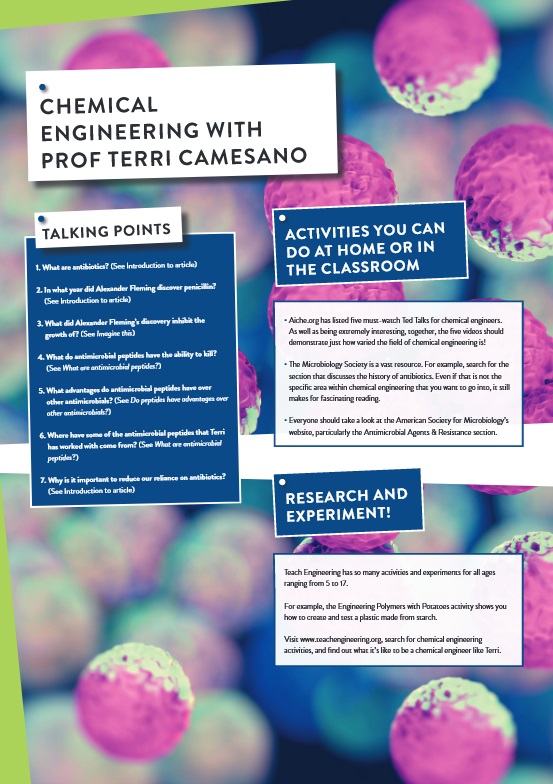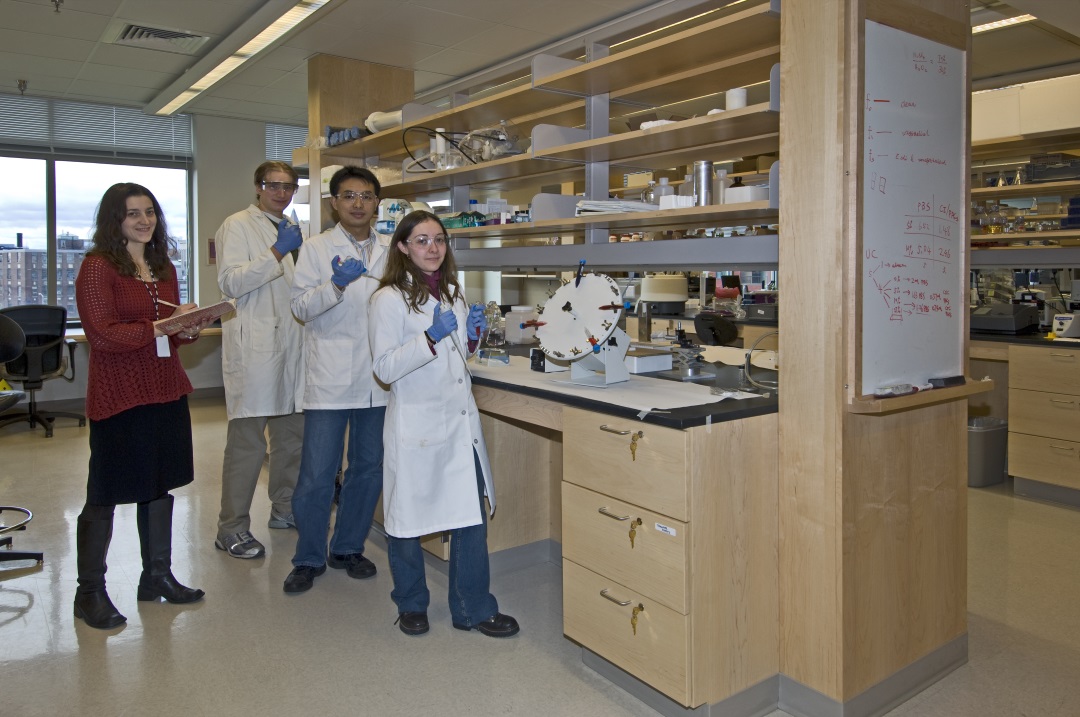The need for antimicrobial peptides in a world of antibiotic resistance
However, the effectiveness of and easy access to antibiotics has led to their overuse and some bacteria have developed resistance. This is a major problem, with the World Health Organization saying that antibiotic resistance is one of the biggest threats to global health, food security, and development today. As a result, the world needs to quickly change the way it prescribes and uses antibiotics to limit the spread of antibiotic resistance.
Researchers around the world are investigating new methods of treating infections and other illnesses, ones that will reduce our reliance on antibiotics in the future. Terri Camesano is a professor of chemical engineering at Worcester Polytechnic Institute in the US. Much of her research is focused on antimicrobial peptides, which have a lot of potential to help people when they are developed into therapeutic treatments.
WHAT ARE ANTIMICROBIAL PEPTIDES?
Antimicrobial peptides are a class of natural molecules that are used by all types of single cell and multicellular organisms. Some of the ones that Terri and her group have worked with come from humans, fish, sheep, and even pigs, and they are part of their immune systems. They have the ability to kill fungi, viruses, bacteria, yeasts, and cancer cells. “I’m interested in them because they have unique antimicrobial properties,” she explains. “For one thing, it is very difficult for humans to develop a resistance to antimicrobial peptides.”
WHAT APPLICATIONS COULD THEY HAVE IN THE BIOMEDICAL AREA?
Antimicrobial peptides have great potential to be used to develop new antimicrobial and anti-infection treatments and therapies. Terri believes they will be especially important in developing strategies to treat bacterial infections that are resistant to our current group of antibiotics. Her team is also looking at whether antimicrobial peptides can be made into a coating that will be placed on biomedical devices, such as catheters or orthopaedic implants. This will help prevent many hospital-associated infections.
DO PEPTIDES HAVE ADVANTAGES OVER OTHER ANTIMICROBIALS?
Yes! The advantages of creating a peptide-based therapy are that they are already naturally occurring – all types of living cells and organisms have them. Antimicrobial peptides are produced in many types of animals and cells, ranging from insects, to giraffes, to humans. They also will be safer and less toxic than many alternatives and are very broad-acting, i.e., they can kill many types of bacteria and viruses.
HOW DO THEY WORK?
Peptides work with a very interesting mechanism, which is more physical in nature. All cells, whether they are in a bacterium or a human, have membranes that encase them and protect the internal components. The antimicrobial peptide works on the bacterial cell membrane. It can sometimes form pores and, in other cases, allow pieces of the membrane to break off. This causes the bacterium to die.
DO PEPTIDES HAVE ANY OTHER EFFECTS?
Some of the antimicrobial peptides have other helpful effects to the body. “One human peptide we work with quite a bit is LL37,” says Terri. “This peptide can also help the body heal from wounds by promoting a positive immune response and decreasing inflammation.”
Reference
https://doi.org/10.33424/FUTURUM23
However, the effectiveness of and easy access to antibiotics has led to their overuse and some bacteria have developed resistance. This is a major problem, with the World Health Organization saying that antibiotic resistance is one of the biggest threats to global health, food security, and development today. As a result, the world needs to quickly change the way it prescribes and uses antibiotics to limit the spread of antibiotic resistance.
Researchers around the world are investigating new methods of treating infections and other illnesses, ones that will reduce our reliance on antibiotics in the future. Terri Camesano is a professor of chemical engineering at Worcester Polytechnic Institute in the US. Much of her research is focused on antimicrobial peptides, which have a lot of potential to help people when they are developed into therapeutic treatments.
WHAT ARE ANTIMICROBIAL PEPTIDES?
Antimicrobial peptides are a class of natural molecules that are used by all types of single cell and multicellular organisms. Some of the ones that Terri and her group have worked with come from humans, fish, sheep, and even pigs, and they are part of their immune systems. They have the ability to kill fungi, viruses, bacteria, yeasts, and cancer cells. “I’m interested in them because they have unique antimicrobial properties,” she explains. “For one thing, it is very difficult for humans to develop a resistance to antimicrobial peptides.”
WHAT APPLICATIONS COULD THEY HAVE IN THE BIOMEDICAL AREA?
Antimicrobial peptides have great potential to be used to develop new antimicrobial and anti-infection treatments and therapies. Terri believes they will be especially important in developing strategies to treat bacterial infections that are resistant to our current group of antibiotics. Her team is also looking at whether antimicrobial peptides can be made into a coating that will be placed on biomedical devices, such as catheters or orthopaedic implants. This will help prevent many hospital-associated infections.
DO PEPTIDES HAVE ADVANTAGES OVER OTHER ANTIMICROBIALS?
Yes! The advantages of creating a peptide-based therapy are that they are already naturally occurring – all types of living cells and organisms have them. Antimicrobial peptides are produced in many types of animals and cells, ranging from insects, to giraffes, to humans. They also will be safer and less toxic than many alternatives and are very broad-acting, i.e., they can kill many types of bacteria and viruses.
HOW DO THEY WORK?
Peptides work with a very interesting mechanism, which is more physical in nature. All cells, whether they are in a bacterium or a human, have membranes that encase them and protect the internal components. The antimicrobial peptide works on the bacterial cell membrane. It can sometimes form pores and, in other cases, allow pieces of the membrane to break off. This causes the bacterium to die.
DO PEPTIDES HAVE ANY OTHER EFFECTS?
Some of the antimicrobial peptides have other helpful effects to the body. “One human peptide we work with quite a bit is LL37,” says Terri. “This peptide can also help the body heal from wounds by promoting a positive immune response and decreasing inflammation.”
This is the part of the technology Terri and her group are currently working on. One of the current strategies is to bind the antimicrobial peptide to another human protein, such as collagen. Collagen can form a scaffold, or support, which will hold the antimicrobial peptides in place and allow the wound healing and antimicrobial activities to take place.
If this can be achieved, our reliance on antibiotics will likely diminish and the team’s work will go some way to resolving the significant issues we face regarding antibiotic resistance. There is still some way to go, but research like Terri’s is paving the way for a new era in treating infections and wounds.
 TERRI CAMESANO
TERRI CAMESANO
Professor of Chemical Engineering and Dean of Graduate Studies
Worcester Polytechnic Institute, USA
FIELD OF RESEARCH: Chemical Engineering
RESEARCH PROJECT: Terri is investigating the use of antimicrobial peptides for the treatment of infections and wounds. One of her current focuses is on finding an effective means to deliver the antimicrobial peptides, which would reduce our reliance on antibiotics.
FUNDERS: National Science Foundation
 Terri Camesano
Terri CamesanoProfessor of Chemical Engineering and Dean of Graduate Studies
Worcester Polytechnic Institute, USA
FIELD OF RESEARCH: Chemical Engineering
RESEARCH PROJECT: Terri is investigating the use of antimicrobial peptides for the treatment of infections and wounds. One of her current focuses is on finding an effective means to deliver the antimicrobial peptides, which would reduce our reliance on antibiotics.
FUNDERS: National Science Foundation
Chemical engineering is applied chemistry. This branch of engineering is focused on the development of chemicals and the manufacture of products using chemical processes. This might include the designing of equipment and processes, through to the mixing and processing of chemicals to create products with a wide range of benefits.
Given this broad definition, chemical engineers generally need a broad skill set. They might apply the principles of chemistry, biology, physics, and mathematics to solve problems associated with the production or use of chemicals, fuel, drugs, and even food.
WHAT CAREER ROUTES ARE AVAILABLE WITH A CHEMICAL ENGINEERING DEGREE?
“I loved chemical engineering as an undergraduate major because it is so versatile. Graduates can go into many different fields, ranging from energy and environment to biotech, pharmaceuticals, petrochemicals, materials, and more,” says Terri. “I also think the skills that we teach chemical engineers translate into many nontechnical areas, as well. We learn to solve problems, work in teams, stick to a budget, and communicate.”
There are many possibilities and opportunities with a chemical engineering degree. While there are traditional paths, it can be used to do other things as well. If you really want to be a professor or start a business, you can do that! There are chemical engineers who have gone on to leadership roles in all types of industrial, academic, and government settings.
WHAT SUBJECTS AND EXTRACURRICULAR ACTIVITIES SHOULD YOU TAKE AT SCHOOL IF YOU ARE INTERESTED IN STUDYING CHEMICAL ENGINEERING?
“I would encourage any student studying engineering to take on some extracurricular activities that are complementary to their studies,” explains Terri. “If you love photography, you can be an officer in the yearbook club or school newspaper. Having a chance to be in a leadership role in a club is also really good experience and will help you in your future career in engineering.”
Students and engineers also often spend a lot of time sitting down, so it is important that you indulge in some physical activity, such as dancing or playing a sport, to keep you fit and healthy. Terri encourages everyone to study mathematics if they can and likes to remind her students that you do not have to be the best at any particular subject, and you do not have to be a “natural” at maths or science in order to become an engineer – the most important qualities are passion and a willingness to work hard.
ISN’T ENGINEERING FOR BOYS? WHY SHOULD MORE GIRLS STUDY CHEMICAL ENGINEERING?
“I truly believe that engineering is for everyone who wants to solve problems and make a difference in the world,” says Terri. “In the US, about 18-20% of engineers are women. That number is steadily growing as more women rise up in the workplace. When I was first starting out, there were a lot fewer women in my field. However, I didn’t let that stop me and stayed focused on my goals, while always seeking out mentors (men and women) who could help me.”
Peer mentors are also really helpful. Early in Terri’s career, she would meet regularly with a group of other assistant professors to share the challenges and triumphs of starting their independent careers.
• A chemical engineer can earn between $51,710 and $66,286 with less than a year’s experience. This can rise to more than $120,000 after 20 years’ experience.
• ThoughtCo. has dedicated a webpage to explaining some of the top reasons to study engineering, including the fact that engineers are happy and make a difference!
• There are chemical engineering internships across the US in a wide variety of sectors, many of which are professional development programmes.
WHAT WERE YOU LIKE AT SCHOOL?
In high school, I always worked hard to learn and achieved high grades. I was also a cheerleader and loved to dance. I grew up in a small town and neither of my parents went to college. I struggled when I first went to college because I didn’t feel as prepared as some of my peers. It took many years for me to gain confidence in myself. I would say that my Master’s degree experience was the most transformative for me. I went from being a shy student, who never reached out, to someone who was always participating in class and always engaged.
I felt a real sense of pride when I finished my Master’s thesis, and then my PhD was relatively easy because I was very sure of myself and very focused. My education also helped me to go out and explore the world. Since I grew up travelling very little, I was thrilled to be able to travel to national and international conferences to talk about my research and meet peers.
WHEN DID YOU DECIDE YOU WANTED TO BE A CHEMICAL ENGINEER?
I didn’t know anything about engineering when I went to college. I was encouraged to go into medicine because that is where a lot of smart students are directed. I planned to major in chemistry and go to medical school. But one of my chemistry professors in my freshman year told me about chemical engineering and suggested that there would be more opportunities, and that it was going to be a great fit for me. I am so glad that I had the guidance of that professor, because I can’t imagine being anywhere else.
WHAT DO YOU THINK IS YOUR GREATEST ACHIEVEMENT TO DATE?
In my personal life, I am raising three intelligent, kind, and wonderful daughters, and that is what I am most proud of in life! Professionally, I feel very proud to be a mentor and an advocate for students. I am amazed at how much they can grow and learn, and I am honoured to be a part of their journey.






